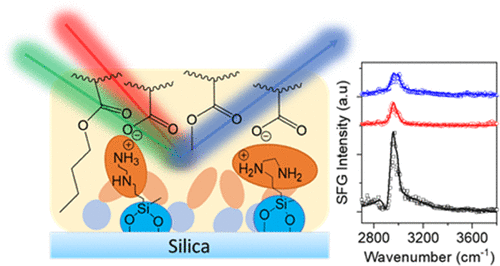Our official English website, www.x-mol.net, welcomes your
feedback! (Note: you will need to create a separate account there.)
Molecular Interactions between Amino Silane Adhesion Promoter and Acrylic Polymer Adhesive at Buried Silica Interfaces
Langmuir ( IF 3.7 ) Pub Date : 2022-05-05 , DOI: 10.1021/acs.langmuir.2c00602 John S Andre 1 , Joseph Grant 2 , Eric Greyson 2 , Xiaoyun Chen 3 , Christopher Tucker 3 , Ray Drumright 4 , Carol Mohler 3 , Zhan Chen 1
Langmuir ( IF 3.7 ) Pub Date : 2022-05-05 , DOI: 10.1021/acs.langmuir.2c00602 John S Andre 1 , Joseph Grant 2 , Eric Greyson 2 , Xiaoyun Chen 3 , Christopher Tucker 3 , Ray Drumright 4 , Carol Mohler 3 , Zhan Chen 1
Affiliation

|
In this study, the influence of an amino silane (3-(2-aminoethylamino)-propyldimethoxymethylsilane, AEAPS) on the interfacial structure and adhesion of butyl acrylate/methyl methacrylate copolymers (BAMMAs) to silica was investigated by sum frequency generation vibrational spectroscopy (SFG). Small amounts of methacrylic acid, MAA, were included in the BAMMA polymerizations to assess the impact of carboxylic acid functionality on the glass interface. SFG was used to probe the O–H and C═O groups of incorporated MAA, ester C═O groups of BAMMA, and CH groups from all species at the silica interfaces. The addition of AEAPS resulted in a significant change in the molecular structure of the polymer at the buried interface with silica due to specific interactions between the BAMMA polymers and silane. SFG results were consistent with the formation of ionic bonds between the primary and secondary amines of the AEAPS tail group and the MAA component of the polymer, as evidenced by the loss of the MAA O–H and C═O signals at the interface. It is extensively reported in the literature that methoxy head groups of an amino silane chemically bind to the silanols of glass, leaving the amine groups available to react with various chemical functionalities. Our results are consistent with this scenario and support an adhesion promotion mechanism of amino silane with various aspects: (1) the ionic bond formation between the tail amine group and acid functionality on BAMMA, (2) the chemical coupling between the silane head group and glass, (3) migration of more ester C═O groups to the interface with order, and (4) disordering or reduced levels of CH groups at the interface. These results are important for better understanding of the mechanisms and effect of amino silanes on the adhesion between acrylate polymers and glass substrates in a variety of applications.
中文翻译:

氨基硅烷助粘剂与丙烯酸聚合物粘合剂在埋二氧化硅界面的分子相互作用
在这项研究中,通过和频振动光谱研究了氨基硅烷(3-(2-氨基乙基氨基)-丙基二甲氧基甲基硅烷,AEAPS)对丙烯酸丁酯/甲基丙烯酸甲酯共聚物(BAMMA)与二氧化硅的界面结构和粘附力的影响。 SFG)。BAMMA 聚合中包含少量甲基丙烯酸 MAA,以评估羧酸官能团对玻璃界面的影响。SFG 用于探测并入 MAA 的 O-H 和 C=O 基团、BAMMA 的酯 C=O 基团和二氧化硅界面上所有物质的 CH 基团。由于 BAMMA 聚合物和硅烷之间的特定相互作用,AEAPS 的添加导致聚合物在与二氧化硅的掩埋界面处的分子结构发生显着变化。SFG 结果与 AEAPS 尾基的伯胺和仲胺与聚合物的 MAA 组分之间形成离子键一致,这可以从界面处 MAA O-H 和 C=O 信号的损失证明。文献中广泛报道了氨基硅烷的甲氧基头基与玻璃的硅烷醇化学结合,留下的胺基可用于与各种化学官能团反应。我们的结果与这种情况一致,并支持氨基硅烷在各个方面的粘附促进机制:(1)尾胺基团与 BAMMA 上的酸官能团之间形成离子键,(2)硅烷头基团与玻璃,(3) 更多酯 C=O 基团迁移到有序界面,(4)界面处CH基团的无序或水平降低。这些结果对于更好地理解氨基硅烷在各种应用中对丙烯酸酯聚合物和玻璃基材之间的粘合力的机制和影响非常重要。
更新日期:2022-05-05
中文翻译:

氨基硅烷助粘剂与丙烯酸聚合物粘合剂在埋二氧化硅界面的分子相互作用
在这项研究中,通过和频振动光谱研究了氨基硅烷(3-(2-氨基乙基氨基)-丙基二甲氧基甲基硅烷,AEAPS)对丙烯酸丁酯/甲基丙烯酸甲酯共聚物(BAMMA)与二氧化硅的界面结构和粘附力的影响。 SFG)。BAMMA 聚合中包含少量甲基丙烯酸 MAA,以评估羧酸官能团对玻璃界面的影响。SFG 用于探测并入 MAA 的 O-H 和 C=O 基团、BAMMA 的酯 C=O 基团和二氧化硅界面上所有物质的 CH 基团。由于 BAMMA 聚合物和硅烷之间的特定相互作用,AEAPS 的添加导致聚合物在与二氧化硅的掩埋界面处的分子结构发生显着变化。SFG 结果与 AEAPS 尾基的伯胺和仲胺与聚合物的 MAA 组分之间形成离子键一致,这可以从界面处 MAA O-H 和 C=O 信号的损失证明。文献中广泛报道了氨基硅烷的甲氧基头基与玻璃的硅烷醇化学结合,留下的胺基可用于与各种化学官能团反应。我们的结果与这种情况一致,并支持氨基硅烷在各个方面的粘附促进机制:(1)尾胺基团与 BAMMA 上的酸官能团之间形成离子键,(2)硅烷头基团与玻璃,(3) 更多酯 C=O 基团迁移到有序界面,(4)界面处CH基团的无序或水平降低。这些结果对于更好地理解氨基硅烷在各种应用中对丙烯酸酯聚合物和玻璃基材之间的粘合力的机制和影响非常重要。






























 京公网安备 11010802027423号
京公网安备 11010802027423号